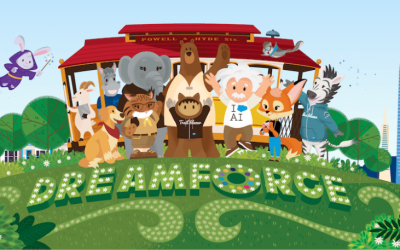Dreamforce Day 2 Recap
1:00 PM, The Art of Transformation, Will Smith
In a delightful Q & A, Will Smith speaks on the power of telling stories that impact people directly, using his own career and personal anecdotes to drive the point home. The timelessness of one of his early iconic roles as the Fresh Prince of Bel-Air, he says, is the product of an appeal to a dream that everyone has – the opportunity to become their best selves without the restrictions of worrying about finance, safety and love.

Will Smith at Dreamforce
As the interview continues, he emphasizes the importance of fun, which he goes on to describe as both a sword and shield emotionally when dealing with difficult situations even from a young age. What we can take away from this is that humor can completely turn around a learning experience and charge it with energy that creates a lasting, positive impression. It can be used as both a tool for “attack” and for “defense”, especially in situations like user training, working with difficult clients, etc. This concept is reflected in the gamified training that Salesforce provides through its online training platform, Trailhead, as well as our many videos on YouTube addressing various Salesforce tricks and tips.
While always striving to find the silver lining and lightness during the learning or business process, he points out that it is also important to “always try to stay focused on the next step”. This is not to say that your mindset should be completely forward thinking and you do not need to also keep in mind current events, but that you should always be ruminating on how your actions are sustainable now and how they set you up for future success. Smith appears to give a nod to the popular TV series Game of Thrones and says that “Winter is coming”. He describes how it is better to plan your business so that it can sustain the inevitable winter and how doing so allows you to embrace it instead of feeling anger or frustration before setting your sights on Spring. We do this all the time with our clients as we build and continuously update a “roadmap” with our clients so they can see exactly where they are going and how each step will impact their business processes for the better. When was the last time that you reviewed your roadmap to reflect on how far you’ve come, and where you’re going in the next few months?
In the last segment, Smith is asked about the timing of his recently published book and also on the topic of generational wealth. He tells the audience that there has never been a better time with the resources available for a black man to tell his story in America and that diversity is crucial now more than ever. In his words, “it is very hard for diversity to make it worse”. As far as generational wealth goes, he recalls the family business his father started that provided refrigerators and ice to various businesses. The most important thing, even as he started his own family that founded several different businesses, is that generational wealth is discussed together and a shared purpose, a family mission, is realized to be upheld above all else. This is not indifferent from a company or team mission as they begin their journey together, and this purpose should be reviewed as your company/team grows to ensure that everyone is aligned and committed through next actions. Friends, when did you last reflect on your mission statement and discuss with your team what it means to them?
1:30 PM, The Future of Admin Success
Salesforce admins build practical solutions for their users. The demo showed Maria, defining admin success with Salesforce by building an object from Google sheets in one easy process. A clean and well-built UX is key to user adoption. Dynamic forms and custom paths can add to the success of the admin building using clicks, not code. AppExchange is a great way to install solutions into your Salesforce org with just a few clicks.

Shonnah Hughes at Dreamforce
Mobile access is a must-have in today’s day and age. Data management, flow, app builder, AppExchange, Tableau – today’s admin can build so much using Salesforce to accelerate admin success.

Gordon Lee at Dreamforce21
Gordon Lee talked about the difference between technical skills and people skills – Salesforce admins need to build listening skills, consensus-building skills, and project management skills. The trust gap – the difference between belief you can do the job and the proof you can do it – can be bridged. Build your own work experience by finding a business pain and solving it with Salesforce.
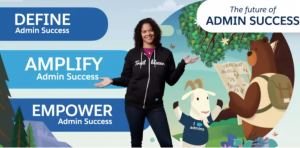
Salesforce Admin Success
The future of admin success can be amplified by sharing knowledge, experience and stories. Mary Tagler gave an example of using Slack and Salesforce Flow to optimize the lead conversion process without manually transferring information between records. She used an after-save flow for lead conversion. She connected Slack to allow lead conversion to send a message in Slack to announce the conversion. Starting off with a basic use case and adding complexity later is a great way to really drive real-world solutions.

Real-world Solutions in Salesforce
Real world solutions should include change management, process automation, and project management. A great demo using screen flows for inventory management was presented. Flow orchestrator allows admins to automate experiences that involve multiple people, multiple stages, and multiple flows. AND: Screen flows can now run natively in Slack!!!
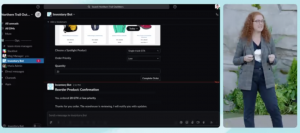
Screen flows in Slack
2:00 PM, Three New Rules Shaping the Future of Business
1: Modern ways of working – Climb Hire believes that there is a lot of potential talent who can provide the skills needed in the Salesforce ecosystem. Modern businesses need to continually expand their talent pools, especially for technical talent. For example, IBM has a new engineer apprentice who was a front-line cafeteria chef. Looking in hidden spots for potential Salesforce talent is a way that businesses can shape their futures.

Climb Hire at Dreamforce
New employees may have never met any of their co-workers in person now that work from home is a reality. Employers should be intentional about mentoring and onboarding new employees as opposed to just throwing employees into the deep end and hoping they figure it out. Have people check in, ask them how they are doing, find out where they are getting stuck and need help without feeling shameful or vulnerable.
Modern businesses require modern ways of working. Modern ways of working require focus on speed, culture, and value.
2: A modern business is an intelligent business – institutional intelligence. Modern technology like Salesforce allows companies to develop this intelligence.
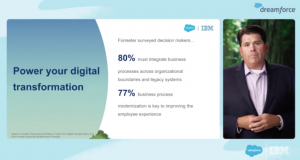
IBM at Dreamforce
Forrester surveyed decision makers and found modern ways of working creates significant employee and customer value. Experiences will be improved across the modern business when automation, AI, and pattern recognition are applied. Technology-infused workflows will build competitive advantage for businesses that recognize the need to create value acceleration. Salesforce, when embedded with intelligent workflows, reimagining processes across multiple areas, see a 70-90% increase in value.
3: Modern businesses build community – we need to look at communities as a competitive advantage. Customers are taking on more complex, larger problems than ever before. Companies need to prepare for the future of business to drive value-based experiences for customers and employees.
Realize, the future of business is now. We will never go back! The tools implemented during the pandemic are now the baseline. Every company needs to consider these three methods to drive a modern business. There is no finish line!
2:30 PM, Design and Build Apps Fast for #AwesomeAdmins
J. Steadman, Lead Admin Evangelist, Salesforce & Claudia Robinson, Product Marketing Manager, Salesforce
Claudia Robinson, a Product Marketing Manager at Salesforce, presents us with a real-life user case for a quick-serve fresh food joint, Poblano, that is looking to optimize their shift and inventory management processes. Their rockstar Salesforce admin quickly designs and spins up an app that creates such an intuitive, clean interface that it makes management cry.
J. Steadman, a Lead Admin Evangelist at Salesforce, walks us through her creation process, starting with a shell of an app, “Shift Manager,” available through the App Manager in Setup.
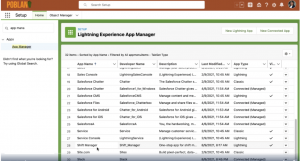
Shift Manager custom Salesforce app
Once the details are finalized and the app page has been created, we then hop over to one of our favorite solution resources – AppExchange – and install the Home/Child Kanban product. This particular app allows you to install a kanban view on your home, app and record pages.

Home/Child Salesforce Kanban App
Once it has been successfully installed, it is time to put that app to work. Using the drag and drop feature, the Kanban component is pulled right onto the page and we can configure it however we like, changing the header, column height, etc. Steadman also walks us through a flow component and report chart that assists the shift managers with viewing how many shifts remain in any given time period throughout the day. Once the components are laid out as desired, he saves and activates the app so we can see it in action.
One of the first things Steadman shows off is how users can easily drag shift tasks under one shift role and drop them in another to spread the workload. Asking for inventory assistance when one shift is running low on ingredients has also never been easier. Check out the eye-catching layout below in the new app.
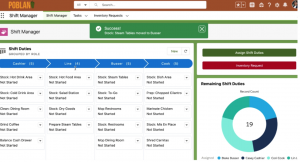
Custom Salesforce App
Finally, the admin is still bothered by how messy this page can become after a while and creates a button “Clean my room” that will clear all data from the page. Steadman enthusiastically leads us through the creation of the button and how to set the component visibility to a user profile name – in this case, system administrator!
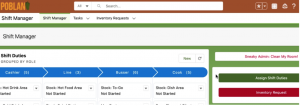
Custom Salesforce App
In less than fifteen minutes, a lengthy and messy process has become completely streamlined and digitized with easier access for all shift managers. Shifts can be filled quicker and more efficiently while inventory requests can be seen and approved in a timely manner. These quick and easy app wins with #AwesomeAdmins are not just for quick-serve food businesses but for everyone! Take a look at your business processes and see if there are any manual processes that may be improved with a Salesforce app, or perhaps automation that can give your team back some valuable time.
4:00 PM, IT’s Five-Step Playbook to Unlock Value from Salesforce
MELISSA MELI Director, Product Marketing, Customer Success, Salesforce; SHANNON TRAN Director, Technical Consulting, Salesforce
- Foundational Governance Strategy: Measure twice, cut once. Consider the perspectives of your digital transformation to your users; success is easier when everyone is on the same page. Create a center of excellence, identify the framework, be clear about the KPIs that you’ll use to measure.
- Design for the Future in Mind: Take the time to think about business processes and how different it will be for your users; co-create the road map with your business partners about the future state and what it would look like.
- Where your data lives will drive your decisions. Think holistically of where your data lives, where it needs to be evaluated, and consider the data pattern and the impact to your users. How long do you need the data to live on the platform for archives and regulations? Align the right data to the right user role.
- Security is Paramount, and a Holistic Approach. Consider security inputs and outputs. Data security and compliance should be planned carefully!
- Do Agile the Salesforce Way. Spend time to adapt your processes to the Salesforce way – DevOps can be more distributed, easier to maintain, and the development process can be supercharged.
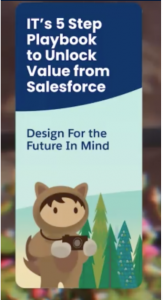
Unlock Value from Salesforce
Check out our Day 1 and Day 3 recaps as well – they have loads more Dreamforce21 info! #DF21
Cloud Adoption Solutions is a 100% woman-owned registered Salesforce partner, specializing in implementation, integration, and optimization for Technology, Healthcare/ Life Sciences, and Financial Services/ Professional Services organizations in the small and mid-commercial sectors.
Contact us with your Salesforce challenges at info@cloudadoption.solutions – we love to help!
SUMMARY KEYWORDS:
Dreamforce, DF21, Salesforce, Salesforce Admin, Salesforce.com, SFDC


